The Bells of St Johns Church

Without the early involvement of Mr Geoffrey Dodds, M.A., of St Albans Abbey, the installation of the Lemsford Bells may never have happened. -To view Bell Gallery Click Here
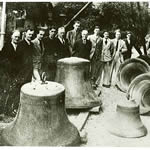 Without the early involvement of Mr Geoffrey Dodds, M.A., of St Albans Abbey, the installation of the Lemsford Bells may never have happened. His dedication and inspirational search for suitable bells, his overseeing of the volunteer construction team and the many hours of hard practical work was an amazing achievement.The excellent team of bell ringers were helped and trained by Mr Dodds with assistance from his wife Joyce and Bob Cochrane from Hatfield. His expertise in all areas of bell ringing contributed enormously to the success of the installation of bells at Lemsford Church.
CLICK ON IMAGE TO ENLARGE
Without the early involvement of Mr Geoffrey Dodds, M.A., of St Albans Abbey, the installation of the Lemsford Bells may never have happened. His dedication and inspirational search for suitable bells, his overseeing of the volunteer construction team and the many hours of hard practical work was an amazing achievement.The excellent team of bell ringers were helped and trained by Mr Dodds with assistance from his wife Joyce and Bob Cochrane from Hatfield. His expertise in all areas of bell ringing contributed enormously to the success of the installation of bells at Lemsford Church.
CLICK ON IMAGE TO ENLARGE
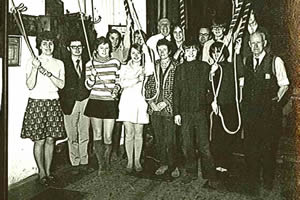
How St. John's, Lemsford acquired its ring of six bells
An account by Geoffrey Dodds
The stone faced brick west tower of the church of St John the Evangelist, Lemsford was provided with a 3 cwt, 23" diameter, mournful sounding bell in about 1859, with the inscription BOWEN OF LONDON, a London founder. It had canons, was lever chimed, was suspended on a timber headstock and swung between a pair of substantial, east-west timber beams resting on stone corbels. A clock was placed centrally lower down. A platform on the same level is on the north side. A short flight of stairs descends to the clock chamber floor, which was the choir vestry ceiling. The clock weight shaft went through the north-west corner (now covered by a square of hardboard). A spiral stairway is on the north-east corner with external entry and doors to the clock chamber, the old bell level and to the roof.
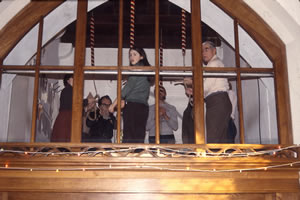
The story begins
The story begins with a request to house the six Shenley bells if necessary. (Two of them were cast in the 17th century). They were set at ground level under a corrugated iron roof, were disused and their Vicar was proposing to sell them without consulting their Parochial Church Council. He could have done so without a Faculty as St Martin's was not a consecrated building. The Lemsford Vicar kindly granted permission. However, Shenley Parochial Church Council were made aware of his proposal and they have since rehung them in a new annex.
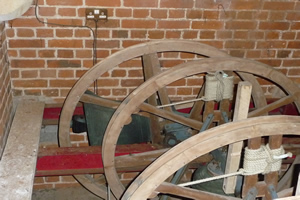
A donation of £1,000
A Hatfield bellringer, Bob Cochrane, who preferred to worship in Lemsford donated £1,000 to buy a ring of bells. However, an estimate from the Whitechapel Bellfoundry for a six new bells, tenor 3 - 4 cwt was, I believe, about £1350. Help! Someone in the Parochial Church Council must have remembered my Shenley request and I was asked what could be done. Many churches, several with rings of bells, were being made redundant and a list of them was kept by the Central Council of Church Bell Ringers, Committee for Redundant Bells. Being a Hertfordshire County Association of Change-Ringers' representative on the Council, I knew my way around They came up with two possibilities, a ring of five or a ring of four bells.
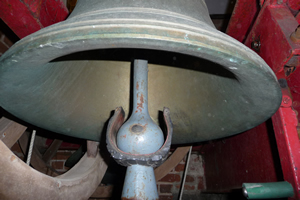
Valuation from Whitechapel
I visited the five bell church, Willey in Telford, Shropshire and found The Manor House alongside occupied by a retired army officer, red~faced, ramrod carriage, baton under his arm, all flowers along his drive were evenly spaced, a perfect 'Colonel Blimp'. 'Bells, please? ''NO!, he owned the church and he intended a full restoration. Not wearing a tie, I retreated rapidly, forgetting to salute. The five bells are now in good condition and are occasionally rung. The four bell church was Holy Trinity, Hatford, Berkshire, near Faringdon. The church was to be sold as a private residence and its parish absorbed into Stanford-in-the-Vale. I phoned the vicar, who directed me to the Oxford Diocesan Office, who directed me on to the Church Commissioners, who directed me to their Redundant Churches office, who directed me to their Estate Agent, - who suggested I try the vicar! Returning from a week's course at Shrivenham on Friday, 19 July 1975, I decided to see the church as it was nearby. I found a Mr. Silcock up a ladder sticking tape over cracks in the church windows, having bought the church and moved in on the Tuesday. He intended to restore the clock, but considered my suggestion of returning the bells to church use a good idea. I guessed a value of £500, for scrap bell metal, but suggested he got a true valuation from Whitechapel. (When the bells went to the Foundry, I was told they were worth about £495). That evening, I passed the news onto the Lemsford Vicar.
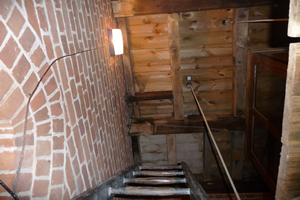
The Bells are purchased
About the next Wednesday the Vicar phoned me; he had bought them! Early in October a working party went over and moved the clock clear of the trap, dismantled the fittings and lowered the bells, using a piano trolley to the church gate where we loaded everything into a builder's lorry belonging to Roland King, churchwarden of Sandridge. As the belfry was 9' 6" square, the same as Lemsford, we also removed the bellframe. All was stored in the school.
Together with a couple of others with some knowledge of bell hanging, we had a meeting with the PCC to decide what to do and what to afford. Money could be saved by D.l.Y.
Scheme 1 Hang the four bells in their timber frame.
Scheme 2 Install a steel frame for six bells, hang the four and add two later.
Scheme 3 Install a steel frame and go for the ring of six bells.
The PCC decided to try for Scheme 3, with assurance of local D.I.Y.
To keep costs down, extra bell metal was obtained by getting the 4 cwt 1858 bell of redundant Christ Church, St Albans for a £70 donation for their choir robes. (A very difficult D.l.Y., the bell lowered externally.) We even added the ½ cwt factory bell of Ballito's / Marconi's, Hatfield Road, St. Albans, which was about to be demolished. Of course, the Lemsford Bowen bell also contributed
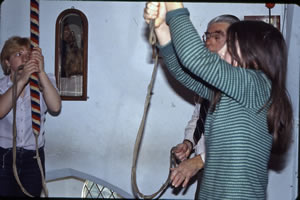
We swung the Bowen bell
During the next months, a Faculty was obtained with the assistance of Eric Edmondson, an architect who worked in the village and was also a bellringer.In November 1976, I measured up the Hatford and Lemsford's timbers and designed joists for the new bell chamber and ringing chamber floors. After Christmas, we swung the Bowen bell, frame high, to test any tower movement - only 0.5 mm. and fixed a timber beam in the north-east corner below the roof, to fix a pulley to hoist heavy material. The bell was then lowered to join the store in the school. Through January, 1977, we lowered the Lemsford beams and removed their corbels, (as the new bellframe would be about 3' lower) and the clock weight case. We began cutting holes in the choir vestry walls for the ringing chamber floor, which would be level with the top of the timber screen. Ten holes had been cut by the 29th.
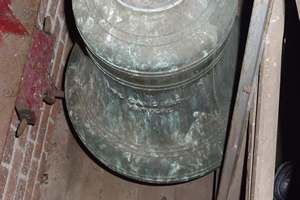
The Bells go to the Whitechapel Bellfoundry
On Sunday, 30th January, Rod Bickerton joined us for coffee after our Morning Service ringing. St Matthew's, Upper Clapton had been destroyed by fire, except for the tower, which was untouched. The parson there seemed to be glad of an excuse to remove his bells and his ringers. Rod had craned out the eight bells through the roof and taken them to replace the near unringable, poor six bells of Watton-at-Stone. Included in the deal was anything else within the tower - but it had to be out by midnight as after then all would be in the hands of the demolition contractors. I phoned the Lemsford Vicar who contacted St Matthew's parson and by the time coffee was finished we had permission to remove the ringing chamber floor. So, after Evensong ringing, Churchwarden Charlie Wager, Dave Dalton, Rod with a wander light with 100 yard lead, saws and a powerful hoist, and myself, plus two estate cars went down. We began cutting the 2" x 9" joists and 1½" floor boards, only to find the tongued and grooved boards had steel tongues. Still, by vigourous use of alternate metal and wood saws we completed the work soon after midnight and the two heavily loaded cars arrived at Lemsford church at about 2 a.m. and were met by Churchwarden Cyril Roden - and a police patrol car. All hands transferred the wood to the school store. With this bounty, the ringing chamber floor had to be redesigned and most of the ten holes filled in.
11th February: Roland King and his lorry loaded all the bells and took them to the Whitechapel Bellfoundry. With an estimate of £4450 (?), a bells appeal was launched.
28th February-2nd April: The ringing chamber floor was made, with a central trap to pass the tenor bell.
2nd April-29th April: A new doorway for the ringing chamber was broken through to the spiral stairs.
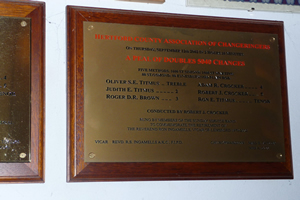
The Clock Mechanism
4th April: Alan Hughes of W.F. came to measure the bell chamber area and on 7th April Bellframe drawings (No. 1) came from W.F. On 14th April I wrote to them disagreeing with the frame width. So, on the 18th April Bellframe drawings (No. 2) came. However, on this day a PCC decision was made to electrify the clock, doing away with the need for a clock weight shaft. Hence, 25th April Bellframe drawings (No, 3) arrived! I could now design the bell chamber floor. As modern floor boarding is fairly thin, I laid out the joists to be under the centre line of each bell pit. If a clapper should work loose and fly out downwards, it would strike the floor safely above a joist with no risk to the clock.
(30th April I was elected President of the Hertford County Association of Change-Ringers for a year. The H.C.A.C.R. Bell Fund granted £300 to Lemsford)
8th April-19th August: Construct the handrail in front of the West window from a top member of the Hatford bellframe, with a wire reinforced glass screen below, retaining chancel view of West window.
13th May-6th July: Build the bell chamber floor joists.
25th May: Cyril Roden registered as builder for V.A.T. purposes. On completion of the job the total cost was much below V.A.T. liability, so saving all V.A.T.
28th May: Took some of our workers to a ringing meeting at Kensworth where there is a similar 'mini' ring of six bells. I noticed that due to the fast rotation of the bell wheels, some of the ropes were thrown against the back of the single pulley block, producing a kick on the rope just as the ringer caught the sally. I phoned Whitechapel to change ours to double pulleys; no problem, just cost a little more. Lemsford bells are easier to ring than Kensworth's.
Friday 3rd June:. With Roland King's lorry, collected the bells, frame, RSJ and all fittings from Whitechapel Bellfoundry and placed the bells in the church, frame members in the churchyard and the wheels and small items in Charlie Wager's garage.
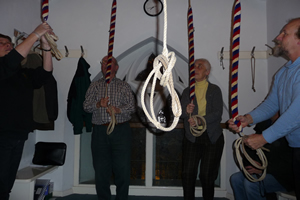
Dedication Service by Robert Runcie
1st June -30th June: Cut holes for foundation east-west RSJ, cast cement sills, lifted RSJ into place and cemented it in.
1st July-6th July: Laid bell chamber floor.
1st July-14th July: Cut holes for bellframe ends, bolted to RSJ and cemented them in place.
9th July-3rd August: Make bellchamber doorway 3' lower, to the level of the new bellframe.
14th July: The Vicar has a letter from a Mr Gamble, describing his simple system for electrifying the clock drive and strike.
21st July-25th July: Clock bell. I had a small 'gardener's' bell from a large house in Isleworth. Middx., discovered in a bombed tree and it was looking for a use. It now hangs on the old timber headstock from the Bowen bell, fixed across the north louvre, to sound over the village. I designed (and temporarily patented) the clock hammer mechanism which was made, free, as an exercise by the Apprentice School of British Aerospace at Stevenage. This is linked to the clock by a cord and pulley.
9th July-5th September: The glass screen filling the tower arch was on its west side and would be at risk by the ringers of bells 1 and 2. So, the glazing was removed, the frame was transferred to the east side, the glazing replaced and short side extensions were carved by Joyce Dodds to match the top of the choir vestry screen. Extra floor boarding was laid for this ringing chamber extension.
6th August-17th August: Bought, modified, painted and fitted ringing and bell chamber doors.
5th August-10th August: Hung bells 4, 5, 3, 2, 1 and 6 (tenor last, as it is over the trap) and fitted wheels, stays, pendulum sliders, etc.
17th August-20th August: Drilled rope holes in bell chamber and clock chamber floors, fitted the Treble rope guide past the clock, fitted ceiling bosses in the ringing chamber ceiling and fixed ground pulley blocks on the bell chamber floor.
5th September-20th September: Roped up and adjusted the depth of 'set' of the bells, made benches in north-west & south-west sides, painted, fixed coat pegs, laid carpet - and many other minor jobs.
25th September: Harvest Festival. Try out, first time for all six bells. Good.
Sunday, 18th December 1977. Dedication Service by Robert Runcie, Bishop of St Albans, as he requested several months ago.
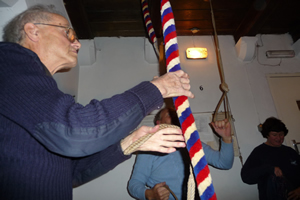
'Lemsford Bells' were on BBC 'Bells on Sunday' and an interview on Anglia TV.
The nucleus of a Lemsford team of ringers, practising on Monday evenings, were soon ringing on Sundays.
27th December 1977: First peal, Plain Bob Minor in 2 hours 18 minutes, by ringers involved in the project
1 Joyce Dodds, Sandridge ringer, general work and wood carving.
2 Theo Crowder, South Mimms ringer, general work.
3 Michael Gloistein, Hatfield ringer, occasional helper.
4 Russell Brown, Hatfield ringer, frequent helper.
5 Eric Edmondson, Hatfield ringer, architect of Faculty plans, (but I did all detail drawings).
6 Geoffrey Dodds, (conductor), St Albans Cathedral ringer, directed and worked on all aspects.
The afternoon after the peal was an open day for visiting ringers to sample the bells.
Without the early involvement of Mr Geoffrey Dodds, M.A., of St Albans Abbey, the installation of the Lemsford Bells may never have happened. His dedication and inspirational search for suitable bells, his overseeing of the volunteer construction team and the many hours of hard practical work was an amazing achievement.Read More

The tower, complete with perforated quatrefoil parapet and corner-mounted dragon gargoyles, remains to this day a prominent landmark in the surrounding countryside. There was no clock until 1876 when the original timepiece was installed by Messrs. Gillet & Bland to the west and south elevations of the tower. The clock is now, of course, electrically powered. If you look closely at both photographs of the church above, the stair turret is just visible above the parapet at the North Eastern corner of the tower. This original feature houses a very steep and narrow spiral staircase that is certainly not for the faint-hearted! Read More

